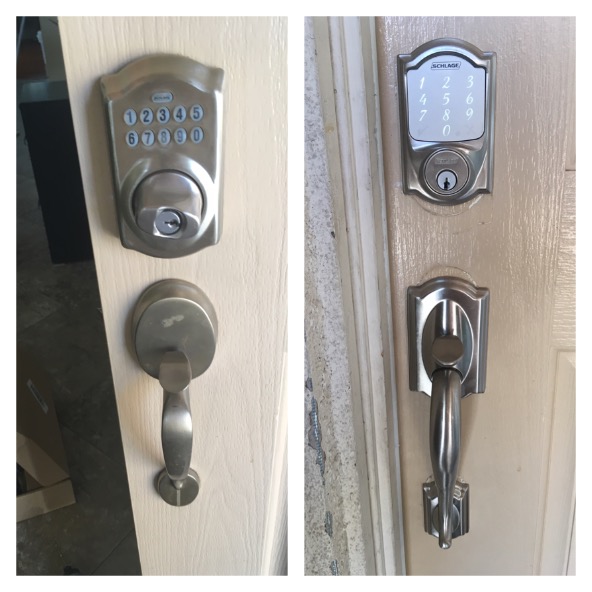Rekeying a lock is replacing the old lock pins with new lock pins. Locks are usually re keyed to build master-key systems, make a set of locks share a common key, or to eliminate compromised keys. Sometimes worn pins are replaced with new pins if the old pins become too short to reach the shear-line. The shear-line is the thin line shared by the plug[1] and it’s cylindrical housing. If a pin sits flush with the circumference of the plug it will allow lock rotation. Lock cylinders use different length pins in different combinations to create relatively unique key bitting. Most keys have 5 cuts from bow to tip. If a key has 5 cuts, the lock has 5 pins. Different brand locks each vary in many small ways, this is most true when servicing them. Many manufacturers offer product specific manuals[2]. Information disclosed in manufacturer manuals is often otherwise difficult to find, as is locksmith material in general.
Pins are manufactured in .003″ increments and .005″ increments, pin kits contain a array of pins organized by length. Lock manufacturers each use specific depth and spacing allowing organized master-key[3] systems to be complex, large, and manageable. A standard pin kit offers the exact size variety needed. Using manufacturer depths permits easy keying, but often you must deviate slightly for optimum accuracy. Pin kits provide master- wafers, top- pins, and springs for a thorough cylinder rebuild. Replace any worn parts, rekey, lubricate, and reassemble. Check to see that the keys work well, check remaining customer keys if any and reinstall.
To rekey a lock you have to first remove the lock cylinder from any housing it rests in. The lock cylinder must be disassembled, and the plug removed. Use a plug follower[4] to avoid dropping master-wafers, top pins and springs. The plug has cylindrical chambers spaced according to manufacturer specifications. Pins are contained in these chambers where they are pushed down by springs or raised by a key. Each cut sits under a chamber of its own, each pin sits on a cut of its own. Place the correct pins in each chamber, bringing the top of each new pin flush with the shear-line. Check the upper chambers using a master-follower for old unused master wafers and remove any. If any springs are noticeably weak or the lock was especially dirty replace the springs. If the old pins are rounded from use or otherwise show excessive wear replace springs. Reinsert the plug taking care not to drop top pins into any unused chamber. Test key, make slight adjustments if needed and reassemble.
Rekeying was first invented in 1836 by Solomon Andrews, a New Jersey locksmith. His lock had adjustable tumblers and keys, allowing the owner to rekey it at any time. Later in the 1850s, inventors Andrews and Newell patented removable tumblers which could be taken apart and scrambled. The keys had bits that were interchangeable, matching varying tumbler configurations. This arrangement later became the basis for combination locks.[5]

New Schlage Handleset and Bluetooth Deadbolt Added by All City Locksmith of Rancho Cucamonga.
This is a new bluetooth deadbolt, here are some of the great features that it offers.
Enter with an access code instead of fumbling for keys
Easy to pair with your smartphone through Bluetooth Smart technology
Easy to get started with Schlage Sense app
Easily share access with trusted friends/family
Easy to install with just a screwdriver
Battery-operated no hardwiring required
Backup key included
Still accepts access codes on touchscreen during home power outages
Lock is easy to update through the Schlage Sense app
Built-in alarm technology senses potential door attacks
No need to buy a new lock when new features are released
3-year electronics warranty; limited lifetime mechanical and finish warranty
Lock/unlock from anywhere on iPhone and Android smartphone with Schlage Sense Wi-Fi Adapter**
Certified Commercial Grade 1
Graded Best in Residential Security, Durability, and Finish
**iPad/Apple TV/Schlage Sense Wi-Fi Adapter must stay plugged into power at home, connected to Wi-Fi and in Bluetooth range (about 40 feet) from the lock to enable remote access.

We can program 75% of todays vehicles in a matter of just minutes. You can either buy the key from anywhere or we can sell you ours. There is a 50/50 Chance when you buy amazon keys. We get all kinds of calls and can handle anything from programming your remotes, replacing lost car keys, unlocking vehicles and homes, rekeying you home or business. Call All City Locksmith today for all your key needs (909) 229-4955 #hondakeys

Are you in need of a replacement clicker? No remote came with your used vehicle? Lost a car key? This is a genuine OEM (Original Equipment Manufacturer) keyless entry key fob. It features 5 buttons: UNLOCK, LOCK, CAR TRUNK, REMOTE START, and PANIC. The item also has a unique spring-released, hidden key blade. It functions as a key or a keyless entry remote at the push of a button! This particular model of flip remote can pair with a variety of Chevy automobiles produced between 2010-2017.

For and additional fee, We can add that extra layer of security to all your locks. This technique can make your locks bump proof and pick proof. We carry Schlage t-pins and spool pins in our work van, so when you call us. We are prepared to take on almost
any job. Don’ be afraid to ask us any questions about making your knobs and deadbolts more secure. We are a professional locksmith company in Rancho Cucamonga and travel trough the Inland Empire on a daily basis. Call All City Locksmith Today for All Your Key Needs.

Here is a job we have done this week working with a used auto dealer. All keys lost and we came to the rescue. We cut and programmed working keys for all the vehicles pictured. Call All City Locksmith for All Your Key Needs. We are located in Rancho
Cucamonga and take the drive all the way to you.

We can cut and Program Most Popular Auto Keys on Demand. We can go the extra mile and drive to you. Making your life easy and less stressful.
The word “transponder” is a portmanteau of “transmitter” and “responder”.[1]
The word came into use around 1945.[1] In basic terms, a transponder is a miniaturized electronic chip that has non-volatile memory, the type of memory that does not need constant energy for retention. Along with that electronic chip is a set of windings, very fine wire coiled around a tube. These windings look similar to the windings one would find in an electric motor.
There are two basic types of transponders. The first are the electric coupled transponder systems. Electric coupled transponder systems are not limited to small areas for transmission but can transmit messages or signals for different ranges of distance including several inches to miles, as used in satellites and airplanes. These systems require large amounts of constant electricity to operate. The second type, used by automobile manufacturers, are called magnetic coupled transponder systems. Magnetic coupled transponder systems are passive in nature. This means they do not require constant electricity and thus do not need a power source of their own. They operate in the frequency range area of 125 kHz. Since magnetic coupled transponders do not have their own power source, they are very limited in range of communication and generally operate in the range of 1 cm to 15 cm. Since this is a radio frequency, it can penetrate materials that would make the transponder not directly visible, such as the plastic or rubber in the bow of a key.
The process of key identification is similar in most automotive transponder systems. Once a key is inserted into the ignition lock and turned to one of the ‘on’ or ‘run’ positions, the induction coil that is mounted around the ignition lock sends out an electromagnetic field of energy. The windings in the transponder chip absorb that energy and power the electronic chip to emit a signal. The signal is usually an alphanumeric sequence which is considered the identification code. The induction coil reads the signal and sends it to some type of computer device to recognize the signal. If the signal is recognized as being already in the computer’s memory, the signal is accepted and other electronic components in the vehicle are set into motion to allow the starting of the vehicle or the continuation of the engine running.
Immobiliser systems based on transponders may not be as safe as they are considered to be. Some immobiliser systems tend to remember last key code for so long that they may even accept a non-transponder key even after a few minutes of taking out the original key from ignition
Install New Garage Door Hardware and Lubricate Door by All City Locksmith of Rancho Cucamonga. No job to big, no job too small, we are here for you 6 days a week providing awesome service. We drive to you as quick as possible or can book an appointment. We also do custom installs, so just give us a call and we will let you know. For all your key needs call us at 909-229-4955 www.allcitylocksmith.net #garagedoors #garagedoorrepair #garagedooropener #garagelock #locksmith #ranchocucamonga #upland #ontario #montclair #3in1one

We make Home Rekeying an easy process. We drive to you and rekey and refurbish all your locks. We also ad the highest quality of lubes on the market for your door lock latches and hinges. The end result is your hardware will be running like new. We serve the city Rancho Cucamonga and service the nearby areas. We provide quality service at very reasonable rates. Call All City Locksmith today for all your key needs.




